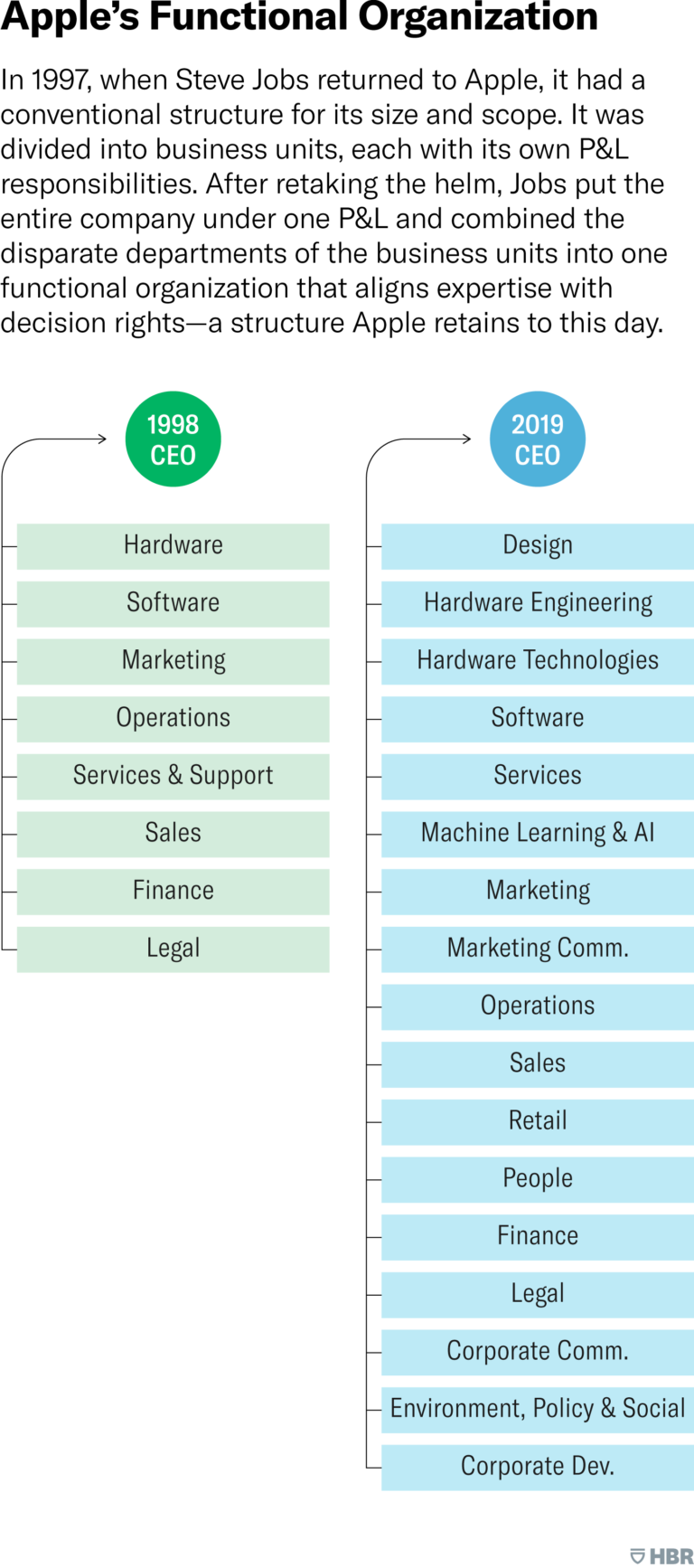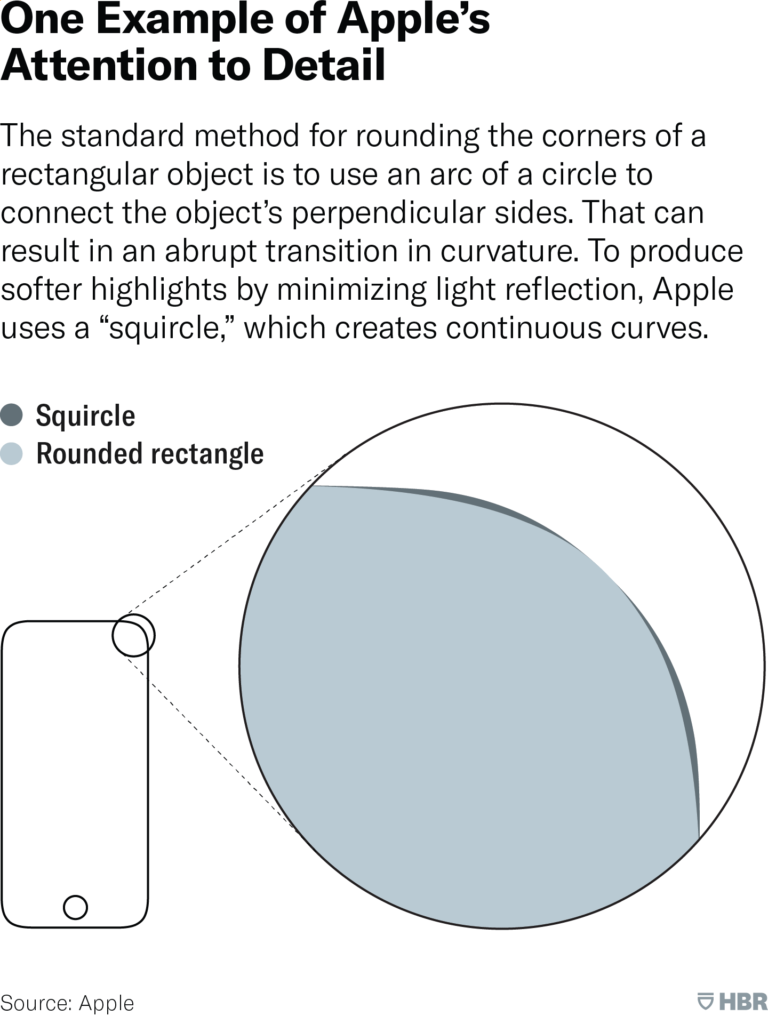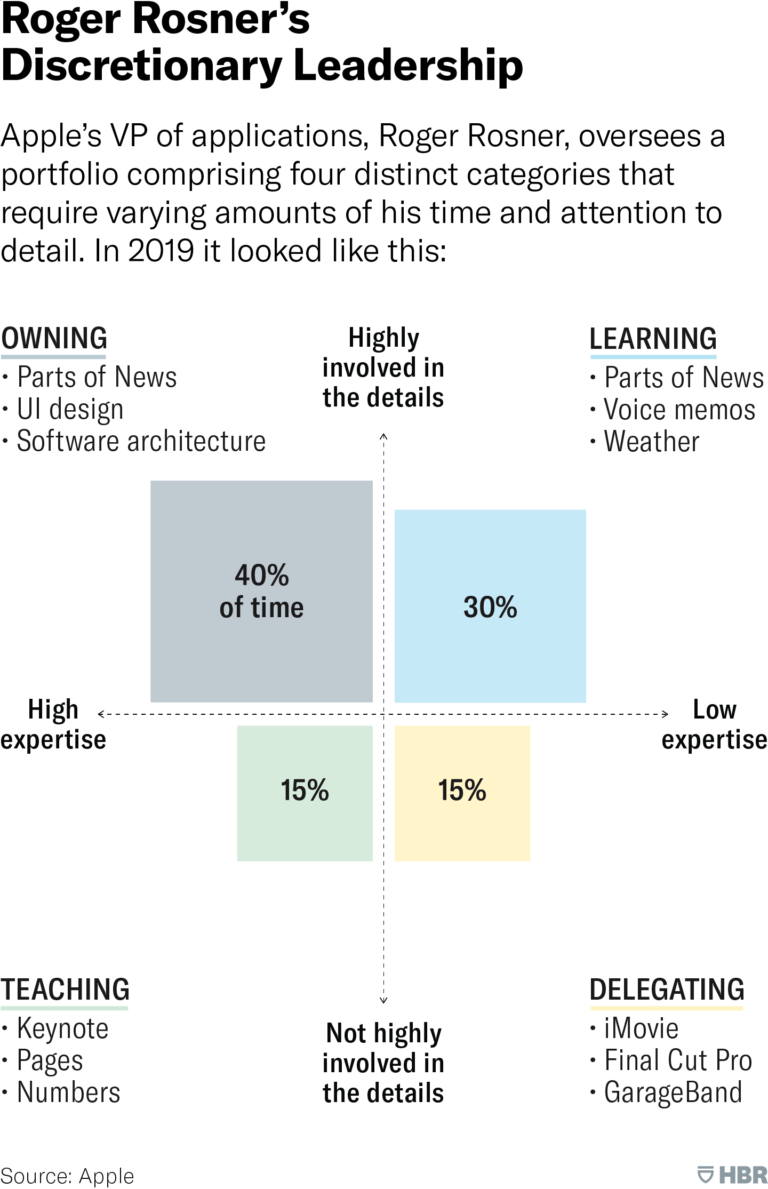Today, Apple University President and Vice President Joel Podolny published an article titled "How Apple is Organized for Innovation" in the Harvard Business Review, which provides an in-depth analysis of Apple's organizational structure and how this structure helps Apple maintain innovation And development.
The article wrote that Apple is known for its innovations in hardware, software and services. However, what is not known is the organizational design and related leadership models that play a key role in leading Apple's innovation and success.
Jobs' return and new organizational structure formation
This model has been implemented since Steve Jobs returned to Apple and has been retained until now.
When Steve Jobs returned to Apple in 1997, the scale and scope of Apple were traditional structures. It is divided into business departments, each of which has its own profit and loss responsibility. After returning to the helm, Jobs put the entire company under a profit and loss statement, and merged the different departments of the various business units into a functional organization, combining expertise with decision-making power, which is the structure Apple still retains.
Two organizational charts show how Apple's structure has changed from 1998 to 2019.
In 1998, the business units reported to the CEO included hardware, software, marketing, operations, service and support, sales, finance, and legal.
In 2019, when the entire company is under an income statement, the departments that report to the CEO include design, hardware engineering, hardware technology, software, services, machine learning and artificial intelligence, marketing, marketing communications, operations, sales, retail, and personnel , Finance, law, corporate communications, environment, policy and society, and corporate development.
For a company the size of Apple at the time, it might not be surprising to adopt a functional structure. Surprisingly, although Apple’s revenue is now nearly 40 times that of 1998, and the level of complexity is much higher than in 1998, Apple still retains this structure.
The senior vice president is responsible for functions, not products. As before Jobs, now CEO Tim Cook occupies the only position on the organization chart. In this position, the design, engineering, operation, and marketing of any major product of Apple There is an intersection with retail. In fact, apart from the CEO, the company does not have a regular general manager: they control the entire process from product development to sales and make judgments based on the income statement.
As Harvard Business School historian Alfred Chandler (Alfred Chandler) records, American companies such as DuPont and General Motors shifted from a functional structure to a multisectoral structure in the early 20th century .
By the second half of this century, most large companies have followed this approach. Apple has proved that the functional structure may benefit companies facing huge technological changes and industry turmoil.
Apple's commitment to functional organization does not mean that its structure remains the same. With the increasing importance of artificial intelligence and other new fields, this structure has also changed. Here, we will discuss the innovative benefits and leadership challenges of Apple’s unique and evolving organizational model, which may be very important for individuals and companies who want to better understand how to succeed in a rapidly changing environment. it works.
Why is a functional organization?
Apple's main purpose is to create products that enrich people's daily lives. This includes not only the development of new product categories, such as iPhone and Apple Watch, but also continuous innovation in these categories. Maybe there is no product that can better reflect Apple's commitment to continuous innovation than the iPhone camera.
In 2007, when the iPhone was launched, Steve Jobs (stevejobs) spent only 6 seconds facing the iPhone camera at the annual new product launch. Since then, iPhone camera technology has made a series of innovations for the photography industry: high dynamic range imaging (2010), panoramic photos (2012), true-tone flash (2013), optical image stabilization (2015), Dual-lens camera (2016), portrait mode (2016), portrait lighting (2017), and night mode (2019) are just a few of the improvements.
Apple's leaders need deep expertise, attention to detail, and collaborative debate.
To create such innovations, Apple relies on a structure centered on functional expertise. Its basic belief is that those who have the most expertise and experience in a certain field should have decision-making power in that field.
This is based on two points of view: First, Apple competes in a market with a high rate of technological change and disruption, so it must rely on the judgment and intuition of people who have a deep understanding of the technology that causes damage. Before obtaining market feedback and reliable market forecasts, the company must bet on which technologies and designs may be successful in areas such as smartphones and computers. Relying on technical experts instead of the general manager will increase the odds that these bets will pay off.
Second, if short-term profit and cost goals are the primary criteria for judging investment and leadership, then Apple’s commitment to providing the best products will be weakened. It is worth noting that the bonus for senior R&D executives is based on the performance figures of the entire company, rather than the cost or revenue of specific products. Therefore, product decisions have nothing to do with short-term financial pressures to some extent. Finance team is not involved in the project team produced goods route chart meetings, project team does not participate in pricing decisions.
We are not saying that Apple does not consider cost and revenue targets when deciding which technologies and features the company will adopt. Yes, but in a different way from those traditionally organized companies. R&D leaders should not regard overall cost and price targets as fixed parameters for design and engineering choices, but should weigh the benefits and cost considerations that these choices bring to users.
In a functional organization, the reputation of individuals and teams is the control mechanism for betting. A good example is that in 2016, iPhone7 Plus decided to launch a dual-lens camera with portrait mode. This is a big bet that the impact of the camera on the user will be sufficient to justify its huge cost.
An executive told us that Paul Hubel is a senior leader who plays a central role in portrait mode work. He is "skiing", which means that he and his team are risking big The risk: If the user is unwilling to pay extra for a higher-priced and better-quality mobile phone, the team may lose credibility next time and propose an expensive upgrade or feature. Facts have proved that this camera is an important feature of iPhone7 Plus, and its success has further improved the reputation of Hubel and his team.
When the decision makers are leaders with deep expertise in their respective fields, rather than the general manager who is mainly responsible for achieving digital goals, it is easier to strike a balance between focusing on costs and increasing the value of user experience. The basic principle of traditional business department structure is to coordinate responsibilities and control, while the basic principle of functional organization is to coordinate professional knowledge and decision-making power.
Therefore, the connection between Apple's organization and the type of innovation it produces is obvious. As Chandler famously said, "The structure follows strategy"-although Apple did not adopt the structure he expected large multinational companies to adopt.
Now let us look at the leadership model behind Apple's structure.
Three leadership characteristics
Since Steve Jobs implemented the functional organization, Apple’s managers at all levels, from senior vice president to the next, are expected to have three key leadership characteristics:
1. Deep professional knowledge, which enables them to meaningfully participate in all work within their respective functions;
2. Focus on the details of these functions;
3. Willing to cooperate and discuss other functions in the collective decision-making process.
When managers have these attributes, decisions are made in a coordinated manner by those who are most qualified to make decisions.
1. Deep professional knowledge
Apple is not a company where general managers supervise managers, but a company where experts lead experts. The assumption is that it is much easier to train a management expert than to train a manager to become an expert. In Apple, hardware experts manage hardware and software experts manage software (deviations from this principle are rare). This approach cascades across all levels of the organization through increasing areas of specialization.
Apple’s leaders believe that world-class talents want to work with other world-class talents in a certain professional field. It's like joining a sports team, where you can learn and play the best.
Long ago, Steve Jobs began to accept this view: Apple managers should be experts in their management field. In an interview in 1984, he said: "We went through that stage at Apple, when we went out and thought, oh, we are going to become a big company, let us hire professional managers. We went out and hired a group of professional managers. People. It doesn’t work at all... They know how to manage, but they don’t know anything professionally. If you are a great person, why do you want to work for someone you can’t learn anything? Do you know what is Is it interesting? Do you know who is the best manager? They are great individual contributors. They never want to be a manager, but they decide that they must be because no one else can do their job well."
An example is Roger Rosner, who is the person in charge of Apple’s software application business, which includes productivity applications such as Pages (word processing), Numbers (spreadsheet), Keynote (presentation), and GarageBand (music synthesis), imo vie (movie editing) and News (applications that provide news content).
Rosner studied electrical engineering at Carnegie Mellon University (Carnegie Mellon), joined Apple in 2001 as a senior engineering manager, was promoted to iWork application director, productivity application vice president, and since 2013, he has served as vice president of applications. Rosner has accumulated a wealth of expertise during his tenure as the engineering director of several smaller software companies, and is a model of expert-level leadership.
In a functional organization, experts leading experts means that experts build a deep bench in a particular field, where they can learn from each other. For example, more than 600 camera hardware technical experts from Apple formed a team led by camera expert Graham Townsend. Because iPhones, iPads, laptops, and desktop computers all include cameras, if Apple is organized by business unit, these experts will be scattered across product lines. This will weaken their collective expertise and reduce their ability to solve problems, generate and improve innovation.
2. Immerse yourself in the details
A principle that runs through Apple is that "leaders should know the three levels of details of their organization" because this is essential for rapid and effective cross-functional decision-making at the highest level. If the manager does not have the details when attending the decision-making meeting, he must make the decision without details, or postpone the decision.
Managers will tell war stories and tell senior leaders who delve into spreadsheets, lines of code, or product test results.
Of course, many company leaders insist that they and their teams know the details. But few organizations can match Apple. Think about how its top leaders paid great attention to the exact shape of the rounded corners of the product.
The standard method of rounding corners is to use the arc of a circle to connect the vertical sides of a rectangular object, which creates a sudden transition from a straight line to a curve. In contrast, Apple’s leaders insisted on a continuous curve, resulting in a shape called "roundabout" in the design world: the slope starts faster, but not so suddenly. One advantage of hardware products without sudden curvature is that they can produce softer highlights (that is, there is almost no jump in light reflection along corners).
The difference between the two is subtle, and its execution is not just a matter of a more complicated mathematical formula. It requires Apple’s operational leaders to commit to extremely precise manufacturing tolerances to produce millions of iPhones and other parenthesized products. This in-depth study of details is not just a question to be pushed to the lower level, but at the core of the leadership.
Leaders who have experts in their respective fields and who can go into details have a profound impact on Apple's operations. Leaders can push, investigate and "sniff" a problem. They know what details are important and where to focus their attention. Many people at Apple believe that working for experts is a liberating and even exciting way of working, because experts provide better guidance and guidance than general managers. Together, everyone can work hard to do the best work of their lives in the region of their choice.
3. Willing to cooperate and debate
Apple has hundreds of expert teams throughout the company, dozens of which may require a key component of a new product. For example, a dual-lens camera with portrait mode requires the cooperation of no less than 40 professional teams: silicon design, camera software, reliability engineering, motion sensor hardware, video engineering, core motion and camera sensor design, etc.
How exactly does Apple develop and ship products that require such coordination?
The answer is cooperative debate.
Because no functional department is solely responsible for products or services, cross-functional collaboration is essential. When the debate is deadlocked (some people will inevitably do), senior managers will participate as decision makers, sometimes including the CEO and senior vice president. Even the most outstanding leaders, in order to achieve rapid pay enough attention to this, and details of a challenge, which makes the company has to make apple fruit shipped vice president of business experience in a number of senior positions held even more important.
However, given Apple's current size, even the executive team can only resolve a limited number of deadlocks. A large amount of horizontal dependence means an invalid peer relationship between the vice president and director levels, which may not only destroy a specific project, but also destroy the entire company. Therefore, in order to gain and maintain leadership in a function, they must be effective collaborators.
This does not mean that people cannot express their opinions. People expect leaders to hold strong, well-founded views and strongly support these views, but when there is evidence that others’ views are better, they are also willing to change their minds.
Of course, this is not always easy. A leader’s ability to be both partisan and open is promoted by two things: one is a deep understanding and loyalty to the company’s values and common goals; the other is a commitment to the correctness and difficulty of a particular path Make the distinction so that the difficulty of implementing the decision does not prevent it from being selected.
The development of the iPhone portrait mode illustrates the leadership’s fanatical attention to detail, the intense debate among teams, and the powerful influence of common goals to resolve the debate and form the final result.
In 2009, Hubel thought of developing an iPhone feature that would allow people to take portrait photos with bokeh-this is a Japanese term that refers to a pleasantly blurred background, and photography experts generally consider this to be the highest quality.
At the time, only expensive single-lens reflex cameras could take such photos, but Hubel believed that through dual-lens design and advanced computational photography technology, Apple could add this feature to the iPhone. His idea fits well with the set goal of the photography team: "More people spend more time taking better images."
As the team worked hard to turn this idea into reality, several challenges arose. The initial attempts produced some amazing portrait pictures, but there were also some "failure cases" in which the algorithm was unable to distinguish the central object (such as the face) in the clear relief from the blurred background. For example, if you want to photograph a person's face from behind a barbed wire fence, it is impossible to construct an algorithm to penetrate the barbed wire fence to capture the side of the face with the same sharpness as the front barbed wire fence.
Someone might say, "Who cares about the individual case? But for the team, avoiding the rare or extreme cases of the "corner case" that the engineers call will violate Apple's strict zero-part engineering standards, which means "by related technology and/ Or any undesired or accidental data changes introduced by technology in the digital processing process. "
Myra Haggerty, vice president of sensor software and user experience prototyping responsible for firmware and algorithms, recalled that this case triggered "many difficult discussions" between the camera team and other related teams. The vice president of the camera software team, Sebastien Marineau Mes (Sebastien Marineau Mes), who finally reported to it, decided to postpone the release until next year in order to allow the team time to better resolve the failure cases—" Pills that are hard to swallow".
In order to reach an agreement on quality standards, the engineering team invited senior design and marketing leaders to meet, thinking they would provide a new perspective. Design leaders added an artistic sensitivity to this debate. They asked: "What makes a beautiful portrait?" To help re-evaluate the zero cultural relic standard, they collected images from great portrait photographers. They noticed that, among other things, these photos are usually blurry at the edges of the face, but the eyes are sharp. So they asked the algorithm team to achieve the same effect. When the team succeeds, they know they have an acceptable standard.
Another problem that arises is the ability to preview portrait photos with blurred backgrounds. The camera team designed this feature so that users can only see its effect on the photo after taking a photo, but the human-machine interface (HI) design team declined, insisting that the user should be able to see the "real-time preview" and get Some guidance on how to adjust before taking pictures.
A member of the HI team, Johnnie Manzari (Johnnie Manzari) gave a presentation to the photography team. "When we saw the demo, we realized this was what we needed to do." Townsend told us. Members of his camera hardware team are not sure they can do this, but difficulty is not an acceptable excuse.
After months of engineering design efforts, the video engineering team (low-level software that controls the operation of sensors and cameras) found a way, and the cooperation paid off. Portrait mode is the core of Apple iPhone7 Plus marketing. Facts have proved that this is the main reason why users choose to buy and enjoy using mobile phones.
As this example shows, Apple’s collaborative debate involves people from different functional departments who disagree, push down, advocate or reject ideas, and propose the best solutions based on each other’s ideas. This requires senior leaders to maintain an open mind. It also requires these leaders to motivate or influence colleagues in other fields to contribute to achieving their goals.
Although Townsend is responsible for the greatness of the camera, he needs dozens of other teams, each with their own list of commitments, to contribute their time and energy to projects in portrait mode. At Apple, this is called uncontrolled responsibility: even if you cannot control all other teams, you are responsible for the success of the project. This process can be messy, but it will produce good results.
When different teams work with a common goal, there will be a "mess", such as portrait mode projects. When the team pushes its agenda before the common goal, a "bad situation" occurs. Those who are associated with a terrible mess and do not change or cannot change their behavior will be removed if they do not take the initiative to remove them from Apple.
Expanding scale leadership
Over the past 20 years, Apple’s organization has brought tremendous innovation and success. However, it is not without challenges, especially since 2008, the surge in revenue and the number of employees has brought huge challenges.
As the company develops, enters new markets, and enters new technologies, its functional structure and leadership model must continue to evolve. Deciding how to organize the professional field to achieve the best collaboration and rapid decision-making has always been an important responsibility of the CEO.
Tim Cook has implemented adjustments in recent years, including dividing hardware functions into hardware engineering and hardware technology; adding artificial intelligence and machine learning as a functional area; moving the human-machine interface out of software, integrating it with industrial design, and creating An integrated design function.
Another challenge brought by organizational growth is the pressure it puts on the hundreds of vice presidents and directors under the executive team. If Apple wants to limit the size or scope of a senior leader’s organization to limit the number and breadth of details that the leader is expected to have, then the company will need to significantly expand the number of senior leaders to make this effective The cooperative approach cannot be maintained.
Aware of this problem, Apple has been very disciplined in limiting the number of senior positions in order to minimize the number of leaders that must be involved in any cross-functional activities. In 2006, the year before the iPhone was released, the company had approximately 17,000 employees; by 2019, this number had increased by more than 8 times to 137,000. At the same time, the number of VPs has roughly doubled, from 50 to 96. The inevitable result is that senior leaders lead a larger and more diverse team of experts, which means more detail and new areas of responsibility beyond their core expertise.
In response, in the past five years or so, many Apple managers have been developing the above-mentioned leadership styles: experts leading experts, focusing on details, and collaborative debates. We have incorporated these adjustments into what we call discretionary leadership and incorporated them into a new education program for Apple’s vice presidents and directors. Its purpose is to meet the challenges and enable this leadership style to drive innovation in all areas of the company, not just product development.
When Apple was small, it might be reasonable to expect leaders to become experts in almost everything within the company and focus on the details. However, they now need to exercise greater discretion in where and how their time and efforts are made.
They must decide which activities require them to concentrate on the details, because these activities create the greatest value for Apple. Some of them will belong to their existing core expertise (which they still need to possess), and some will require them to learn new areas of expertise. Activities that require less attention from the leader can be pushed to others (the leader either teaches others or authorizes them if they are not experts).
Rosner, vice president of applications, provides a good example. Like many other Apple managers, he had to deal with three major challenges brought about by Apple's tremendous growth.
First of all, in the past ten years, both the total number of employees (from 150 to about 1,000) and the number of ongoing projects at any given time, the scale of his function has exploded. Obviously, he could not delve into all the details of all these projects.
Second, his business scope has expanded: in the past 10 years, he has been responsible for developing new applications, including news, editing (video editing), books, and Final Cut Pro (advanced video editing). Although applications are his core area of expertise, some of these aspects, including news editing content, book publishing work methods, and video editing, all involve Rosner’s not-experts.
Finally, with the expansion of Apple's product portfolio and number of projects, more coordination with other functional departments is required, which increases the complexity of collaboration across multiple departments. For example, Rosner is responsible for the engineering aspects of news, while other managers are responsible for overseeing the operating systems, content, and business relationships with content creators (such as the New York Times) and advertisers on which news depends.
In order to cope, Rosner adjusted his role. As an expert leading other experts, he has been focusing on details, especially those related to the top-level aspects of software applications and the details of their architecture, which affect how users use the software. He also works with managers across the company and participates in projects involving these areas.
But with the expansion of responsibilities, he has moved some things out of his box, including some traditional productivity applications such as Keynote and Pages. Now, he coaches other team members and gives feedback so that they can develop software applications according to Apple's specifications. Being a teacher does not mean that Rosner is mentoring on the whiteboard; on the contrary, he made strong and often passionate criticisms of the team’s work (obviously, it is difficult for general managers without core expertise to teach that they don’t know s things).
Roger Rosner’s discretionary leadership.
Roger Rosner, Apple's vice president of apps, is responsible for managing a portfolio of four different categories, which require different time and attention to detail.
The situation in 2019 is like this: A chart ranks these four categories according to Rosner's degree of expertise (x-axis) and involvement in details (y-axis).
40% of his time is spent in the "own" box (where the expertise and involvement in details are the highest), which contains parts of Apple news, user interface design and software architecture. His "learning" box (30% of the time, low expertise, high detail) contains parts of Apple news, voice memos and weather forecasts. His "authorization" box (15% of the time, low expertise, low detail) contains iMovie, Final Cut Pro, and GarageBand. His "teaching" box (15% of his time, high expertise, low detail) contains topics, pages, and numbers.
The second challenge Rosner faced was to add some activities to his original expertise. Six years ago, he was assigned to be responsible for news engineering and design. Therefore, he must learn how to publish news content through apps to understand news publications, digital advertising, machine learning personalized news content, privacy architecture, and how to incentivize publishers.
Therefore, some of his works fall into the learning box. In this case, managers face a steep learning curve in acquiring new skills. Considering how high this requirement is, only key new activities should fall into this category. After six years of intense study, Rosner has mastered some of these areas, which are now in his own box.
As long as a particular activity is still in the learning box, the leader must adopt a beginner's mindset and ask subordinates in a way that implies that they don't know the answer (because they don't know). This is very different from how the leader asks his subordinates about the activities in the teaching box.
Finally, Rosner has integrated some areas, including iMovie and GarageBand, and he is not an expert in people with the necessary abilities. For the activities in the authorization box, he convened the team, reached an agreement on the goal, monitored and reviewed the progress, and made the team responsible: the general manager.
Apple’s vice presidents spend most of their time in the owning and learning box, while the general managers of other companies spend most of their time in the authorization box. Rosner estimates that he spends 40% of his time on activities he owns (including working with others in a certain field), 30% for learning, 15% for teaching, and 15% for authorization. Of course, these numbers vary from manager to manager, depending on their business and the needs of a particular time.
The discretionary leadership model retains the basic principles of an effective functional organization that coordinates expertise and decision-making power on a scale. When leaders like Rosner take on new responsibilities beyond their original expertise, Apple can effectively enter new areas, and when leaders impart their skills and delegate work, the size of the team can also expand. We believe that through this organization, Apple will continue to innovate and prosper.
Apple's functional organization is rare if not unique among very large companies. It runs counter to the popular management theory, that is, the company should be reorganized into departments and business units when it gets bigger. But in the process of transferring to the business department, something crucial was lost: the consistency of decision-making power and professional knowledge.
Why does the company always insist that the general manager be in charge of the business department? We believe that one of the reasons is that it is difficult to make changes. It needs to overcome inertia, redistribute power among managers, change the individual-oriented incentive system, and learn new ways of cooperation. When a company is already facing huge external challenges, this is daunting. An intermediate step may be to develop an expert model of expert leadership, even within a business unit structure.
For example, when taking on the next senior management position, you should pick someone with deep expertise in the field, not someone who might become the best general manager. However, a comprehensive transformation requires leaders to also transform into a functional organization. Apple’s performance proves that these returns may justify these risks. Its methods can produce extraordinary results.








Thank you for providing such important and informative information. An organizational structure may assist you in determining a company's leadership hierarchy and information flow. These can be useful guidance for any sales force to attain their portfolio goals.
ReplyDeleteThe method involved with moving your documents from a PC to a Mac is clear. Simply download the documents to a USB or FireWire hard drive and afterward plug this into your Mac. macosxtutorial.com
ReplyDelete